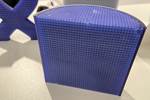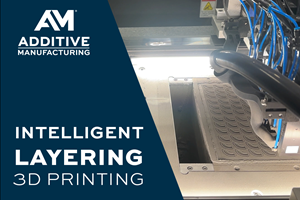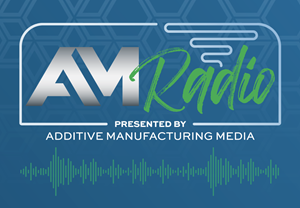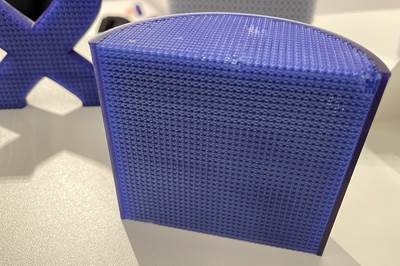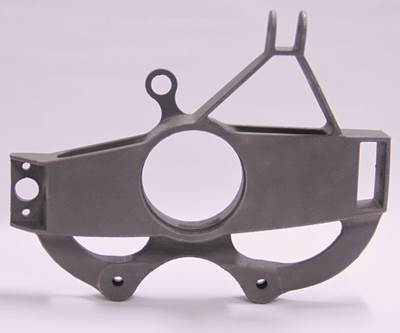Software is one of the factors that make additive manufacturing infinitely flexible; without reliance on hard tooling such as molds, fixtures or cutting tools, AM makes it possible to reproduce a given part directly from a digital file.
But the STL format, which is the most widespread file type for communicating part geometry to the 3D printer, is now becoming something of a hindrance. 3D printers work by different mechanisms, and even machines from the same builder may not behave identically. The STL file type, which conveys only geometry, nothing else, potentially leaves quite a bit open to chance. A different file format called 3MF is now growing in adoption, in part because it can capture and deliver more information.
“3MF is both part and build file,” says Duann Scott, executive director at the 3MF Consortium, the organization tasked with the ongoing development of this newer, though now well-established file type.
While 3MF does offer an alternative to geometry files such as STLs, it can also serve as a container for various types of information beyond geometry. 3MF can carry data about the build including metadata about the file author, slicing information, materials and even printer parameters; it can even contain more than a single object to deliver a full build of parts to the printer.
Challenges with STLs
STL, which stands for standard tessellation language or standard triangle language, represents shapes as meshes, essentially translating geometries into a web of triangles that connect at their vertices. While STLs can represent a wide range of geometry, the need to convert surfaces into this triangle representation can cause downstream impacts to the 3D printing process. Representing features such as curves to STL for instance can cause artifacts in the print and prevent a smooth surface from being created.
Complexity might be “free” in AM, but it requires increasingly larger STL file sizes. As a part such as this becomes more optimized (and therefore more complex), representing its geometry through STL creates more and more data. Source: 3MF Consortium
In addition, STL files can be complex and large in terms of data because geometry is represented literally (in other words, shapes are explicitly modeled). One reason for this comes from the triangles themselves, Scott says.
“In an STL, the vertices of the triangles are counted each time they are referenced. That means every vertex is recorded three times,” he says.
But as 3D printing technology has become more sophisticated and capable, the larger issue with STLs might be that they only contain geometry, and only cover a single part.
“An STL is for discretizing a design to send to a 3D printer as a single object,” Scott says. But most 3D printers can print multiple objects at once. And with the growing capabilities around multimaterial and tunable prints, a single STL may not be able to contain all of the build instructions for even a single object. 3D printing users today often compensate by creating multiple STLs to represent different colors or other properties, and essentially “layering” them — adding complexity and introducing room for error.

This graph represents the relationship between part mass and STL file size. The example parts shown below illustrate how, as the part’s physical mass is reduced through organic forms and lattices, its STL file size grows exponentially. Representing the same forms through 3MF, by comparison, results in significantly smaller files. Source: 3MF Consortium
Understanding 3MF
The 3MF format aims to solve many of these challenges at once. The file type originates with efforts from Microsoft to support 3D printing, but has been further developed by the 3MF Consortium which formed in 2015. Today the organization has more than 36 members consisting of various hardware and software companies that manage the format.
At its most basic, the 3MF file format is a zipped XML file. Data is stored as plain text and compressed; when dealing with very complex geometries, 3MF enables smaller file sizes than STL, allowing them to be transmitted and shared more easily.
“Even if you are working with a triangular mesh, with 3MF each vertex can be recorded just once — resulting in a file size reduction of one-third just by exporting into this format,” Scott says. 3MF also supports a range of different extensions for specific design cases.
Take, for instance, a lattice. Using an STL file, each strut of the lattice would need to be “wrapped” in triangles in order to represent each part of this pattern. But using the “Beam Extension” available with 3MF, lattice details can be communicated as a graph of information about strut lengths and end points, dramatically reducing the amount of data without loss of details.
3MF’s lattice extension allows for faster file loading, lattice, and meshing times and also results in smaller files. Source: 3MF Consortium
But 3MF is not just a lighter-weight substitute for STL. It is intended to be a more accurate depiction of the part, as well as a more complete picture of its surrounding details.
“We’re capturing the entire workflow into one streamlined data solution,” Scott says. In addition to information about part geometry, 3MF can contain details about different colors or materials; build parameters; IP and authorship; and metamaterial properties. The range of data that 3MF can convey is particularly helpful for multimaterial builds; with a layered STL strategy, the interfaces between materials can result in sheer or other discontinuities, but storing all material information within one 3MF file enables them to intertwine via gradients.
“If the digital thread contains multiple files that have to travel together, there is room to introduce error,” Scott says. “This is a less fragile thread, less subject to getting broken or tangled.”
Beyond just individual parts, 3MF can be used to represent an entire build volume. Here, 48 insoles nested inside HP 3D Builder can either be represented as 48 individual meshes in 31,000 kilobytes of data, or as a 179-kilobyte 3MF file carrying all 48 instances. Source: 3MF Consortium
Looking Ahead
The 3MF file format continues to evolve as more members join the consortium and new needs are identified. 3MF Consortium is currently working on a volumetric extension that brings implicit modeling capabilities to the 3MF format, planned for introduction at CDFAM in October 2024. This extension is intended for handling more complex shapes such as gyroids. By using math equations to represent geometries, the extension makes it possible for such geometries to be treated as constants across many tools and printers.
“It’s a truth that is not possible in other formats,” Scott says.
The specification for 3MF’s implicit modeling extension will be published later this year, providing support for smaller and more streamlined files for models and meshes created with this technique. Source: 3MF Consortium
Another solution the Consortium is working on is how to stream 3MF data as layer-by-layer slices directly to the 3D printer, further reducing file transfer requirements. This functionality has not yet been released, but could reduce the data load from a one-time transfer of gigabytes down to continuous kilobytes.
Scott emphasizes that 3MF is a living file format, one that is meant to evolve along with additive manufacturing based on user feedback — and this represents a potentially unique opportunity.
“There are real humans working on this now, today, and we’re always open to feedback,” Scott says. “This is a lucky position in the history of manufacturing, to have this feedback loop and an organization that can implement changes.”
Related Content
Video: What Is Electron Beam Melting (EBM)?
Electron beam melting is the higher-energy metal 3D printing process offering advantages when it comes to productivity and thermal stresses. Here is an introduction to EBM.
Read MoreThe AM Ecosystem, User Journeys and More from Formnext Forum Austin: AM Radio #43
Sessions and conversations at the first U.S. Formnext event highlighted the complete additive manufacturing ecosystem, sustainability, the importance of customer education, AM user journeys and much more.
Read MoreVideo: Intelligent Layering Metal 3D Printing at 3DEO
Contract manufacturer 3DEO delivers metal parts using Intelligent Layering, a binder jetting-like 3D printing process the company developed and operates internally. Here’s how it works.
Read MoreThe New Misperceptions Of AM: AM Radio #35
Tim Simpson and Peter Zelinski discuss a way additive manufacturing has advanced: The misperceptions have shifted. Knowledge of AM among manufacturers is more sophisticated now. The concerns that inform the perceptions of newcomers have therefore changed.
Read MoreRead Next
Implicit Modeling for Additive Manufacturing
Some software tools now use this modeling strategy as opposed to explicit methods of representing geometry. Here’s how it works, and why it matters for additive manufacturing.
Read MoreUnderstanding the As-Printed Surface of a Metal 3D Printed Part
The model definition for additive manufacturing imposes inherent challenges that impact the dimensions, tolerances and appearance that you can (or cannot) achieve on an “as built” part.
Read More

.jpg;width=70;height=70;mode=crop)
